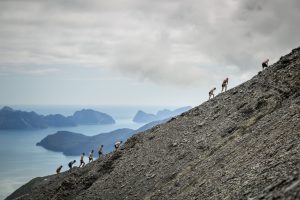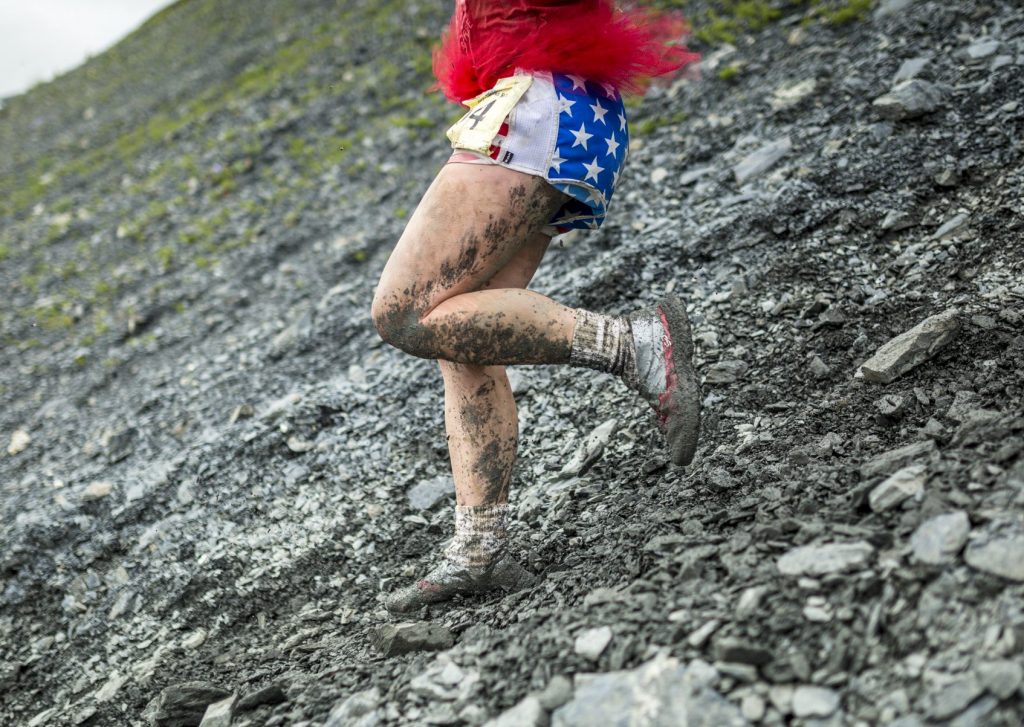
According to folklore …
The tradition of the Mount Marathon Race began when two sourdoughs debated the possibility of climbing and descending the mountain in less than an hour. “Impossible” one said.
To settle the argument and the resulting wager, a race was held, with the loser to furnish drinks for the crowd. Enterprising merchants put up a suit of clothes and other prizes for the winner and proposed the race take place on a holiday – why not the Fourth of July?
The optimistic sourdough lost his bet. The winning racer took one hour and two minutes.

The Mount Marathon Race became an organized run in 1915 and has since become the biggest draw of the Independence Day celebration in Seward. Over the years, this historic event has drawn increased participation and resulted in new milestones.
- 1963 – First women’s racer (Jane Trigg)
- 1964 – First junior race held (won by Seward’s Dale Shea)
- 1967 – First junior girls winner (Barbara Britch)
- Pre-1985 — Races capped at a combined 200 runners
- 1985 — Separate women’s race established (54 finished)
- 1991 — Men’s finishers (230) exceeds 200 for first time
- Early 1990s — Men’s race expanded from 200 to 300 entrants
- 1995 — July 3 auction created (held at Yukon Bar)
- 1996 — Women’s race reaches capacity of 300 for first time
- 1997 — Men’s race reaches capacity of 300 in 48 hours
- 1998 — Priority registration established for finishers of the previous year’s race and veteran runners with 10 or more finishes
- 2003 — Lottery application system established for new racers
- 2003 — Winners of Alaska Mountain Runners Grand Prix Series races receive one-year special invite to MMR the following year
- 2004 — Men’s and women’s races expanded to 350 entrants each
- 2004 — Men’s and women’s wave start implemented (only 50 runners in first wave)
- 2005 — Two equal-sized waves implemented
- 2007 — Historical tracking of bib numbers in database begins
- 2010 — Junior races expanded to 250 entrants
- 2012 — Priority registration tightened to include top 225 (instead of all finishers)
- 2014 — Top 10 overall finishers receive one-year invite the following year
- 2014 — Weighted lottery adopted
- 2016 — Junior race expanded to 300 entrants (150 boys and 150 girls)
- 2018 — Golden Racer option for age 70+ added
- 2019 — Waitlist tested (and abandoned)
- 2019 — Junior race canceled due to wildfire smoke
- 2019 — Entry fee raised to $85 for adults and $35 for juniors (From $65/$25)
- 2020 — Top 50 Percent Age-Group Rule and 10-Year New Racer Repeal Rule added
- 2020 — Men’s and women’s races expanded to 375 entrants each; 3rd wave added
- 2020 — All races canceled due to pandemic
- 2021 — Race held on July 7 to limit pandemic crowding
- 2024 — Non-binary division added with its own results and awards
- 2024 — General deferrals eliminated; pregnancy deferral added
- 2024 — Junior age minimum raised to 9 years old
- 2025 — Entry fee raised to $100 for adults and $50 for juniors (From $85/$35)
- 2025 — RunSignUp registration platform adopted; weighted lottery eliminated, lottery retained
The Oldest U.S. Mountain Race, but not quite the oldest race!
The Mount Marathon Race is the oldest mountain race in North America, but it is not the oldest running race.
Below is a list of older races in the United States (information obtained at www.arrs.net). There are 12 footraces older than Mount Marathon, which was first raced in 1915. However, it’s accurate to say Mount Marathon is “among the oldest footraces” in North America.
Oldest U.S. Road Races
- 1896 – Delaware YMCA Turkey Trot 8K
- 1897 – Boston Marathon
- 1907 – Jackson Day 9K (New Orleans)
- 1907 – New Orleans AC Turkey Day 5M
- 1907 – Yonkers Marathon (N.Y.)
- 1908 – Run for the Diamonds 9M (Berwick, PA)
- 1908 – Thanksgiving Day 10K (Cincinnati)
- 1912 – Bay to Breakers 12K (San Francisco)
- 1914 – Lexington Patriots Day 5K (Lexington MA)
Oldest U.S. Cross Country Races
- 1892 – Bemis-Forslund Pie Race 4.3 miles (Gill, MA)
- 1904 – Schuylkill Navy 5.6 mile (Philadelphia, PA)
- 1910 – Dipsea Race 6.8 miles (Stinson Beach, CA)
- 1915 – Mount Marathon Race 3.1 miles (Seward, AK)